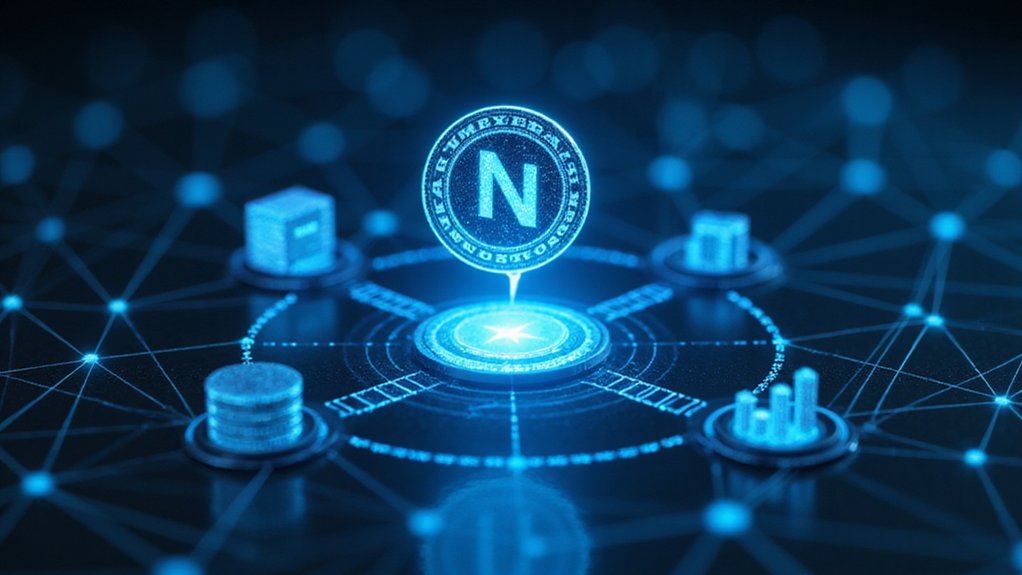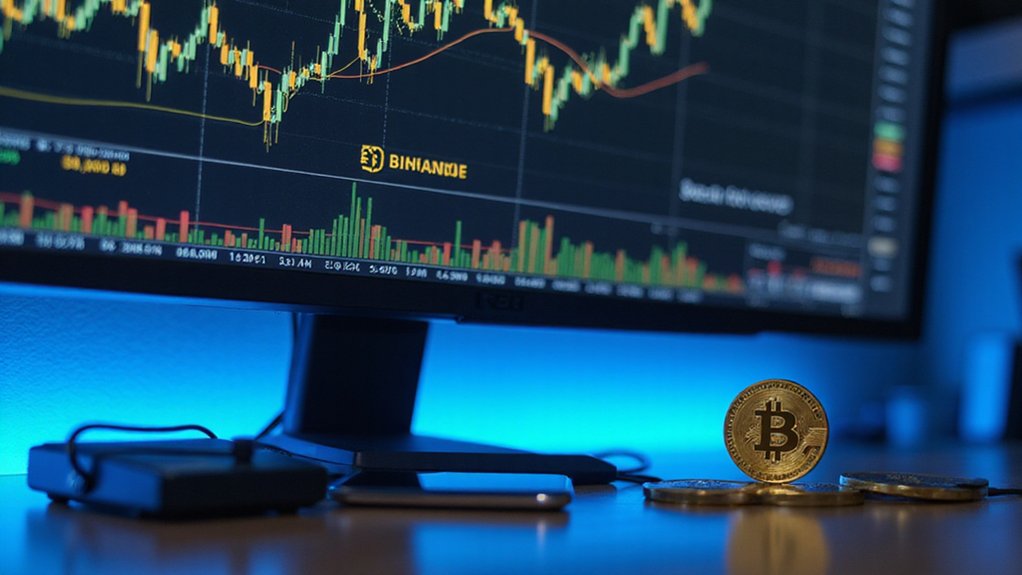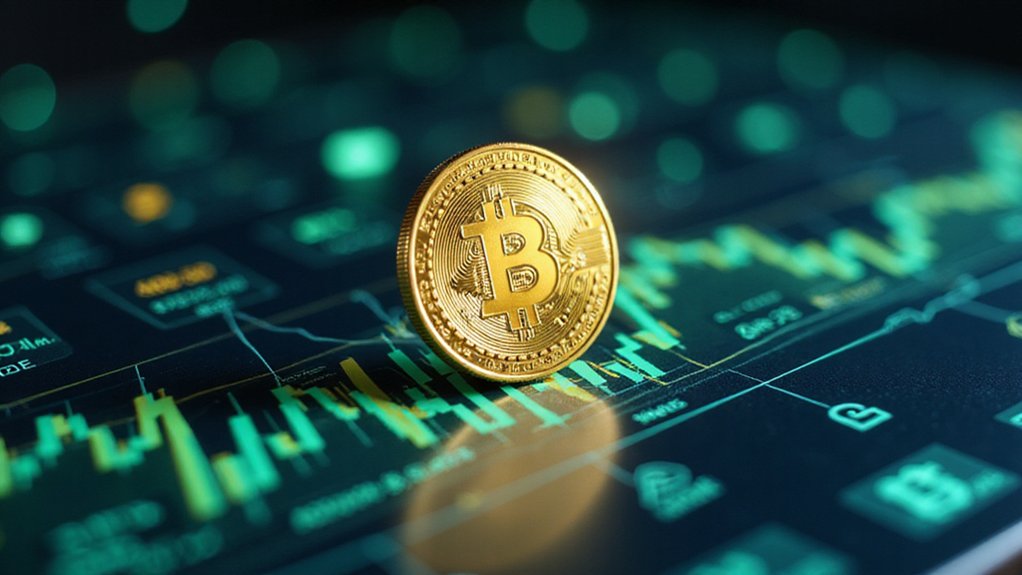The NEAR token serves multiple functions within its ecosystem: it facilitates transactions through gas fees, secures the network via proof-of-stake validation, acts as collateral for blockchain data storage, enables governance participation, and supports cross-chain interoperability through Rainbow Bridge. Its economic model incorporates supply management strategies while providing developer incentives through gas rebates. This multifaceted utility—transaction medium, security instrument, and governance mechanism—positions NEAR not merely as speculative currency but as fundamental infrastructure. Further exploration reveals its ingenious approach to blockchain’s persistent challenges.

The NEAR token serves as the essential lifeblood of the Near Protocol ecosystem, functioning far beyond a mere digital asset traded on exchanges.
At its most fundamental level, NEAR facilitates transactions across the protocol, with users paying gas fees denominated in the token—a familiar arrangement to anyone who’s navigated Ethereum’s occasionally eye-watering fee structure.
Yet while transaction facilitation remains table stakes for any respectable blockchain token, NEAR’s utility extends considerably further.
In the domain of network security, NEAR employs a proof-of-stake consensus mechanism wherein token holders can stake their assets to participate in transaction validation.
Staking transforms NEAR holders from passive investors to active network guardians, simultaneously securing infrastructure and generating rewards.
This arrangement—simultaneously elegant and pragmatic—incentivizes validators through token rewards while fortifying the network against nefarious actors who might otherwise attempt to compromise its integrity.
The economic calculus here proves compelling: validators acting in good faith receive compensation, while the protocol itself benefits from distributed, attack-resistant infrastructure.
NEAR tokens further serve as collateral for data storage on the blockchain, effectively converting digital value into persistent computational memory—an exchange that, while perhaps appearing arcane to outsiders, represents a rather ingenious solution to blockchain’s perennial storage challenges.
Meanwhile, governance participation rights accrue to token holders, allowing them to influence protocol development through a mechanism that (at least in theory) aligns decision-making authority with economic stake.
The token’s interoperability functions—particularly through the Rainbow Bridge—enable cross-chain asset transfers with Ethereum and other networks, mitigating the blockchain ecosystem’s notorious fragmentation. This cross-chain capability represents a crucial component of NEAR’s vision to provide chain abstraction that efficiently streamlines execution across multiple blockchain networks.
For developers, NEAR incentivizes application building through gas fee rebates and scalability solutions that address persistent throughput limitations plaguing older blockchain architectures.
NEAR’s economic model incorporates supply management strategies designed to balance growth with stability—no small feat in cryptocurrency markets where volatility remains the only true constant.
Through this multifaceted utility profile, NEAR has positioned itself as not merely a speculative vehicle but a functional token with genuine technological purpose—something rarer in the cryptocurrency space than many care to admit.
This energy efficient consensus approach significantly reduces the environmental impact compared to proof-of-work systems, aligning with growing concerns about blockchain sustainability.
The platform’s unique implementation of Thresholded Proof-of-Stake enhances security by requiring validators to stake NEAR tokens and risk slashing penalties for any malicious behavior, creating strong economic incentives for proper network operation.
Frequently Asked Questions
How Are NEAR Token Prices Determined?
NEAR token prices emerge from a complex interplay of market forces.
Supply-demand mechanics form the foundation, while broader crypto sentiment and macroeconomic conditions provide context.
The token’s value fluctuates with ecosystem adoption rates, as increased platform usage naturally drives demand.
Staking mechanisms temporarily remove tokens from circulation, creating supply constraints.
Regulatory developments, large-scale transfers, and strategic partnerships further influence price dynamics.
The token’s inflationary model—lacking a hard cap—adds another variable to this intricate valuation equation.
Can I Mine NEAR Tokens?
NEAR tokens cannot be mined through traditional proof-of-work methods.
Unlike Bitcoin’s energy-intensive mining, NEAR operates on a Nightshade proof-of-stake consensus mechanism where participants earn tokens through staking and validation rather than computational mining.
What’s often mistakenly called “mining” in the NEAR ecosystem (particularly on Telegram) actually refers to claiming HOT tokens—an entirely different asset with a gamified claiming system requiring periodic user interaction rather than hardware-intensive operations.
What Makes NEAR Different From Other Cryptocurrency Tokens?
NEAR distinguishes itself through its Nightshade sharding technology—enabling parallel transaction processing across multiple shards—which dramatically enhances throughput compared to competitors.
Beyond this technical edge, NEAR offers human-readable account names (rather than cryptographic addresses), remarkably low transaction fees, and developer-friendly tools.
Its Rainbow Bridge facilitates Ethereum interoperability, while its governance model allows token holders meaningful participation in protocol evolution—features that collectively position NEAR uniquely in the increasingly crowded cryptocurrency landscape.
How Secure Is the NEAR Blockchain for Token Transfers?
The NEAR blockchain employs robust security measures for token transfers, combining protocol-level safeguards with cross-shard architecture.
Its one-yoctoNEAR deposit requirement guarantees transaction authenticity, while receipt-based processing prevents double-spending.
Smart contracts implement explicit security checks and follow audited standards.
Cross-chain transfers via Rainbow Bridge maintain asset integrity through cryptographic verification.
The economic disincentives against spam (those pesky gas fees!) and consistent execution rules across shards create a remarkably resilient ecosystem for moving digital assets.
Will NEAR Tokens Be Limited in Supply Forever?
NEAR tokens are not limited in supply forever.
Despite beginning with 1 billion tokens at Genesis in April 2020, the protocol’s design includes a perpetual inflationary mechanism of approximately 5% annually – with 4.5% allocated to validators and 0.5% to the treasury.
This deliberate inflation, combined with the gradual vesting of Genesis tokens (scheduled to complete by April 2025), creates a continuously expanding supply without a permanent cap – a feature rather than a bug in NEAR’s economic model.









